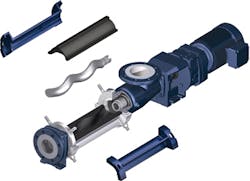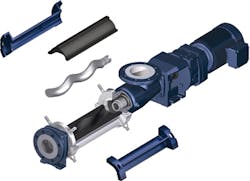Case Study: Pumping System Smoothes Magnesium Hydroxide Application
A major chemical supplier company was trying to reduce the buildup of slag in their coal-powered plant's chimneys with the use of magnesium hydroxide. The plant was having difficulties transferring the thick and chalky substance, also referred to as milk of magnesium, from one tank to the next.
Milk of magnesium is considered a safe alternative to harsh chemicals with relatively low impact on the environment. However, inadequate mixing, improper piping, and incorrect pump selection are common tricky areas for this application and the facility would frequently run into problems when attempting to pump the chemical.
The magnesium hydroxide slurry being pumped in this application is made up of 50-60 percent solids and is a very sticky and viscous liquid that is somewhat difficult to process. The company attempted to use several different kinds of pumps to get the job done, but in the end, the seepex BN range progressive cavity pumps complete with Smart Stator Technology (SST) and Smart Conveying Technology (SCT) proved most reliable. They also provided the easiest maintenance and technical service.
The pumps are available with various rotor and stator geometries and can be applied to virtually all industrial sectors to convey viscous materials containing solids. Offering a controlled flow with minimal pulsation, the pump conveyed the milk of magnesia slurry gently from one tank to the next without leakage, without freezing up, and without suffering excessive wear.
Normal and expected wear that any kind of pump may succumb to when pumping magnesium hydroxide is quickly repaired on the seepex pumps, according to the plant's Site Operations Manager. One of the pumps being used is equipped with the seepex Smart Stator Technology and the other with the company's Smart Conveying Technology.
The technologies provide simple access to the rotor and stator for inspection without the need to dismantle pipelines. The removal of foreign material or blockages is resolved in a fraction of the time spent servicing prior pump types, saving up to 80 percent in maintenance times. The lifecycle costs of the pumps have been reduced thanks to less downtime and fewer service personnel.
The pumps also helped reduce the plant's energy consumption. Compared to previously used centrifugal pumps, which required 15 horsepower motors, and diaphragm pumps that required 10 horsepower motors, the seepex model is able to run using a two horsepower motor.
The facility currently has three seepex pumps in use. One has been operational for two years and has yet to show any signs of deteriorating and has not required any service.

